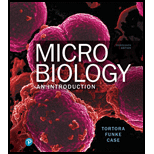
To review:
The roles of T cells and B cells in adaptive immunity.
Introduction:
The immune system is defined as the group of cells or tissues or organs that functions against the foreign substance to provide the immunity. The immunity is classified into two categories, innate and adaptive.
Immunoglobulins are produced by plasma cells, which contain the antigen binding site that allow the antigen to bind. They are found in blood, tissues and other body fluids to make the immune system.
Antibodies and lymphocytes are the major elements in the adaptive immune system. The lymphocytes consist of B cells, cytotoxic T cells and Helper T cells which are involved in the adaptive immune response against the infectious pathogens.
Want to see the full answer?
Check out a sample textbook solution
Chapter 17 Solutions
Microbiology: An Introduction (13th Edition)
- What is the difference between innate immunity and adaptive immunity?arrow_forwardDistinguish between a. neutrophil and macrophage b. cytotoxic T cell and natural killer cell c. effector cell and memory cell d. antigen and antibodyarrow_forwardDescribe how antibody-mediated immunity fights against pathogens.arrow_forward
- Describe how T cells and B cells arise and function in adaptive immunity.arrow_forwardElaborate by diagrammatic representation the various types of Immunity?arrow_forwardDescribe the roles that phagocytic and nonphagocytic cells and plasma proteins such as complement and interferon play in innate immunity?arrow_forward
 Human Biology (MindTap Course List)BiologyISBN:9781305112100Author:Cecie Starr, Beverly McMillanPublisher:Cengage Learning
Human Biology (MindTap Course List)BiologyISBN:9781305112100Author:Cecie Starr, Beverly McMillanPublisher:Cengage Learning Human Heredity: Principles and Issues (MindTap Co...BiologyISBN:9781305251052Author:Michael CummingsPublisher:Cengage Learning
Human Heredity: Principles and Issues (MindTap Co...BiologyISBN:9781305251052Author:Michael CummingsPublisher:Cengage Learning

